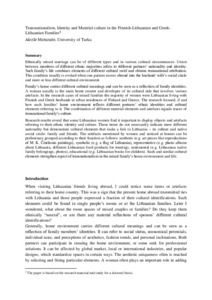Transnationalism, Identity and Material culture in the Finnish-Lithuanian and Greek-Lithuanian Families
Akvile Motuzaite
https://urn.fi/URN:NBN:fi-fe2021042718876
Tiivistelmä
Ethnically mixed marriage can be of different types
and in various cultural circumstances. Union between members of different
ethnic majorities refers to different partners’ nationality and identity. Such
family’s life combines elements of different cultural swirl and obtains
transnational attribution. This condition usually is evoked when one partner
moves abroad into the husband/ wife’s social circle and more or less different
cultural environment.
Family’s home carries different cultural meanings and
can be seen as a reflection of family identities. A woman usually is the main
home creator and developer of its cultural side that involves various
artefacts. In the research cases of mixed families the majority of women were
Lithuanian living with Finnish and Greek husbands in urban residences of
Finland and Greece. The research focused, if and how such families’ home
environment reflects different partners’ ethnic identities and cultural
elements referring to it. The combination of different material elements and
artefacts signals traces of transnational family’s culture.
Research results reveal that some Lithuanian women
find it important to display objects and artefacts referring to their ethnic
identity and culture. These items do not necessarily indicate mere different
nationality but demonstrate cultural elements that make a link to Lithuania –
its culture and native social circle: family and friends. The artefacts
mentioned by women and noticed at homes can be preliminary grouped according to
their function as follows: aesthetic (e.g. art pieces like reproductions of M.
K. Čiurlionis paintings), symbolic (e.g. a flag of Lithuania), representative
(e.g. photo-albums about Lithuania, different Lithuanian food products for
treating), sentimental (e.g. Lithuanian native family belongings, photos),
educational (e.g. Lithuanian books for children). Such and similar cultural
elements strengthen aspect of transnationalism in the mixed family’s home
environment and life.
Kokoelmat
- Rinnakkaistallenteet [19207]
